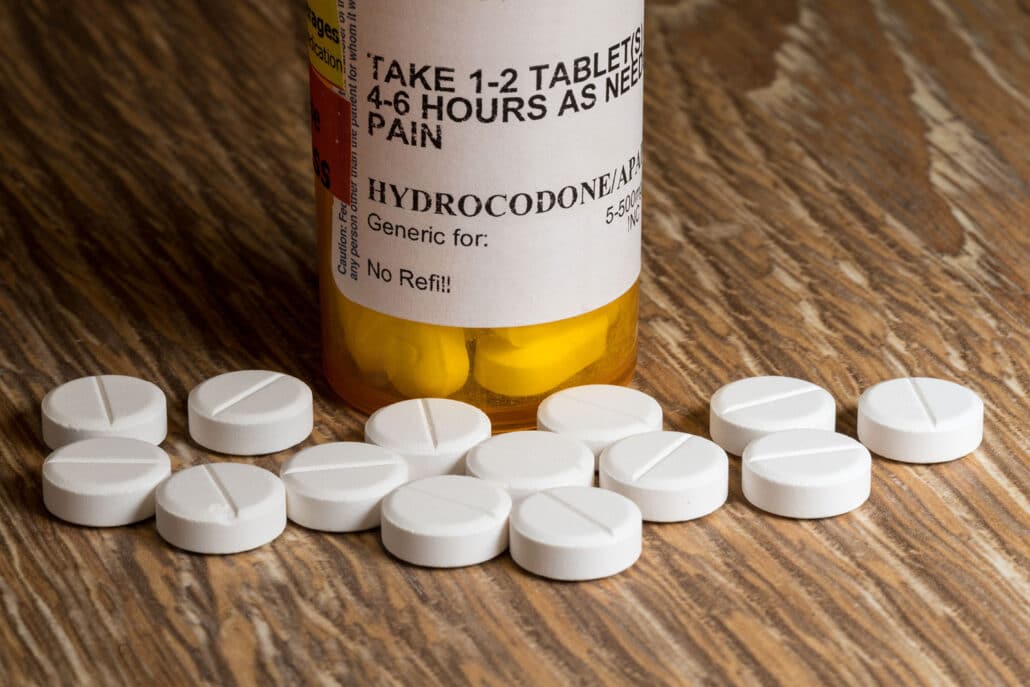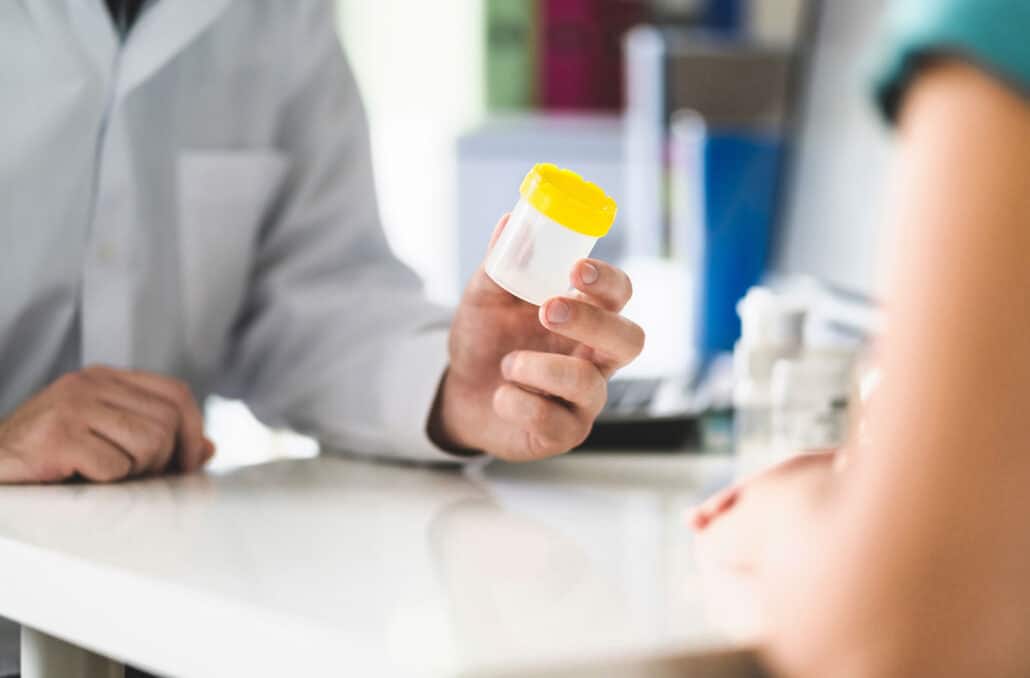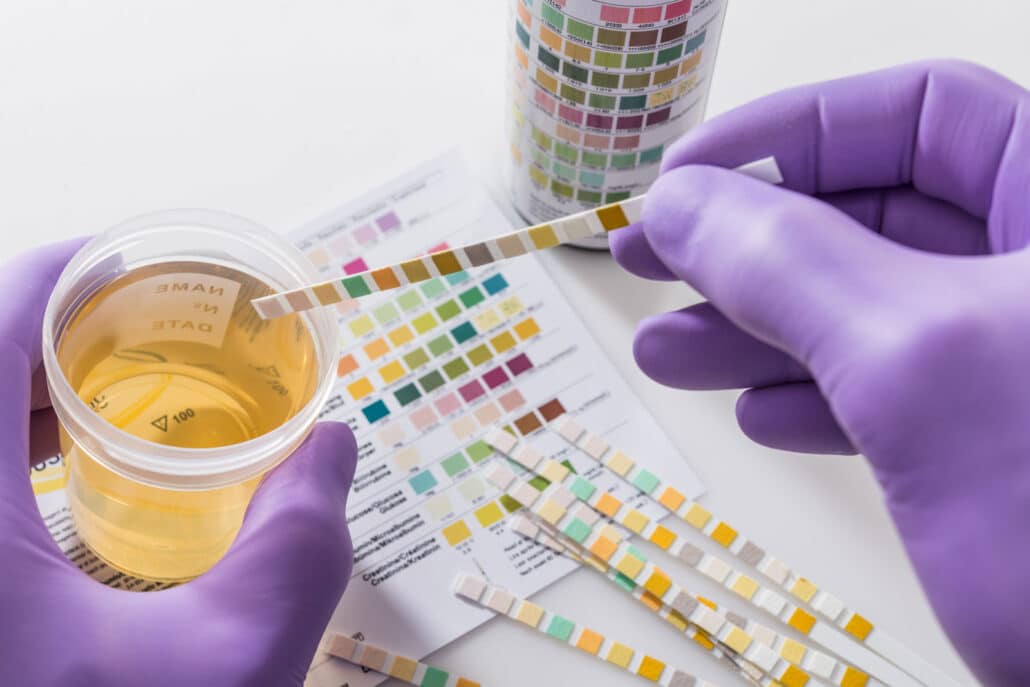Hydrocodone is a prescription analgesic medication belonging to the class of drugs known as opioids.
Unlike morphine and codeine, which are natural opioids, hydrocodone is a semi-synthetic opioid developed specifically for medical use.
Often combined with acetaminophen (paracetamol), hydrocodone is commercially available under several names including Vicodin, Lortab, Norco, Hysingla, Lorcet, and Zohydro ER.
This potent pain medication is one of the most commonly prescribed in the US, with one of the most significant abuse rates among patients.
Hydrocodone is categorized as a Schedule II drug, characterized by a high potential for causing dependence, overuse, and addiction.
With such risk surrounding hydrocodone use, understanding how the body deals with it is crucial for both medical professionals and individuals in the context of detox and treatment plans.
This guide explores how long hydrocodone lasts in urine.

Table of Contents
- 1 How Does Hydrocodone Affect the Body?
- 2 Side Effects of Hydrocodone
- 3 How Long Does Hydrocodone Stay in the Body?
- 4 How Long Does Hydrocodone Stay in Urine?
- 5 Can You Detect Hydrocodone in the Parts of the Body?
- 6 Factors That Affect the Duration of Hydrocodone Detection in Urine
- 7 Can Hydrocodone Give a False Positive in a Urine Test?
- 8 What To Expect During a Hydrocodone Urine Test
- 9 What If Hydrocodone Appears in Your Urine Test
- 10 Conclusion: Seeking Help
How Does Hydrocodone Affect the Body?
Hydrocodone is a prescription-only drug used to alleviate moderate to severe chronic pain, such as in the conditions of cancer and arthritis. It’s also sometimes prescribed to treat chronic cough and after major surgeries
Hydrocodone elicits its analgesic and sedating effects by binding to opiate receptors and activating them. This prevents the brain from producing certain chemicals that trigger sensations of pain and irritation, and instead, increases dopamine levels.
As a result, the brain’s reward system is altered, so not only do you experience pain relief but also feelings of numbness, drowsiness, lowered stress, and euphoria.
Hydrocodone is available as oral capsules or tablets, meaning that you’ll only feel the effects of the drug after it passes through your digestive system. It takes about an hour for enough hydrocodone to get into the blood to start relieving pain sensations.
The highest concentration of hydrocodone in the blood occurs about 1.3 hours after ingestion (assuming a dose of 10 mg). But this can take longer in patients who’ve been using the drug for some time.
With continued use, the brain gets used to the presence of hydrocodone and builds tolerance to the drug. Individuals may then resort to taking larger doses of hydrocodone to reach the same effects and function normally.
Side Effects of Hydrocodone
Hydrocodone is an opioid analgesic prescribed for managing moderate to severe pain. While effective, it is associated with a range of side effects, varying from common to severe.

Common Side Effects
- Gastrointestinal Issues: Nausea and constipation are frequently reported.
- Neurological Symptoms: Dizziness, drowsiness, and headache may occur.
- Dry Mouth: Some individuals experience a dry mouth sensation.
Serious Side Effects
- Respiratory Depression: Hydrocodone can cause slowed or stopped breathing, especially during the initial 24 to 72 hours of treatment or following a dose increase.
- Adrenal Insufficiency: Symptoms include darkening of the skin, diarrhea, dizziness, fainting, loss of appetite, mental depression, nausea, skin rash, unusual tiredness or weakness, or vomiting.
- Severe Allergic Reactions: Signs encompass rash, itching, hoarseness, difficulty breathing or swallowing, or swelling of the hands, face, or mouth.
Other Potential Side Effects
- Sleep-Related Breathing Problems: Hydrocodone may cause sleep-related breathing problems (e.g., sleep apnea, sleep-related hypoxemia).
- Liver Issues: Symptoms include pain or tenderness in the upper stomach, pale stools, dark urine, loss of appetite, nausea, unusual tiredness or weakness, or yellow eyes or skin.
It’s crucial to take hydrocodone precisely as prescribed and to communicate any side effects to your healthcare provider promptly. They can provide guidance on managing side effects and determine whether adjustments to your treatment are necessary.
How Long Does Hydrocodone Stay in the Body?
We can estimate the period that a drug remains in the body by calculating its half-life; that’s the time needed by the body to eliminate half the drug’s dose.
Assuming a standard dose of 10 mg, hydrocodone has an average half-life of approximately 3.8 hours.
The amount of time required to completely get rid of the drug consists of several half-lives, which is roughly five in the case of short-acting hydrocodone.
- In the case of long-acting hydrocodone, the half-life of the drug is between 7 to 9 hours. As such, eliminating an entire dose would take from 35 to 45 hours.
The body generally clears over 90% of a hydrocodone dose after around 18 to 24 hours. Most people will stop experiencing the effects of hydrocodone at this point even though it didn’t fully exit the body.
Whether or not the presence of hydrocodone can be detected depends on the area of the body that undergoes testing.
How Long Does Hydrocodone Stay in Urine?
The estimated detection window of hydrocodone in urine is around 24 to 96 hours. So if you take hydrocodone, it can show in a urine drug test 1 to 4 days after ingestion.

Can You Detect Hydrocodone in the Parts of the Body?
Yes, hydrocodone can be detected when testing other areas of the body. The detection window in those parts varies from urine and from one another as follows:
Detection Windows
| Test Type | Detection Window | Notes |
|---|---|---|
| Urine Test | 1 to 4 days | Hydrocodone can be detected in urine for approximately 1 to 4 days after the last dose. |
| Blood Test | Up to 24 hours | In blood, hydrocodone is detectable for up to 24 hours post-ingestion. |
| Saliva Test | 12 to 36 hours | Saliva tests can identify hydrocodone use within 12 to 36 hours after consumption. |
| Hair Test | Up to 90 days | Hair follicle tests can detect hydrocodone for up to 90 days, reflecting long-term use. |
It’s important to note that these are general guidelines, and individual experiences may vary. If you have concerns about hydrocodone detection or its effects, consult with a healthcare professional for personalized advice.
Factors That Affect the Duration of Hydrocodone Detection in Urine
The exact duration that hydrocodone stays in urine varies from one person to another depending on several factors controlling the drug’s clearance rate. Here are the primary factors to consider:
Frequency and Duration of Use
A patient who’s taking hydrocodone multiple times per day will have the drug in his system for longer than a person who only takes a single dose.
Similarly, a patient who’s been taking hydrocodone long-term will require more time to eliminate the drug than someone who’s only used it for a few days.
A higher frequency or a longer duration of using hydrocodone results in tolerance. This pushes people to take more medication to get the desired effect, adding more hydrocodone to their bodies which will extend its stay.
Dose Consumed
When a medical professional prescribes hydrocodone, they calculate the appropriate dosage based on the patient’s overall weight and body fat.
The body composition affects the rate of drug metabolism. If you consume a relatively too large dose, the elimination process will be prolonged and so will the detection window of hydrocodone.
Genetics and Metabolism
The breakdown of hydrocodone in the body relies on certain enzymes that vary in quality and quantity depending on each person’s genes.
The higher the quality of these enzymes and the higher their number, the faster the drug is metabolized.
Age
Generally, younger people have a better capacity for breaking down medication thanks to their faster metabolism. They also tend to have healthier organs, particularly the liver and kidneys, which are vital for elimination processes in the body.

Can Hydrocodone Give a False Positive in a Urine Test?
Because hydrocodone is a synthetic opioid, it’s only available as a medication. In other words, no plant, food, or beverage contains hydrocodone, so the potential for it to be in your system from a non-medication source is nonexistent.
That said, if you take a urine drug test while using hydrocodone, it may show traces of the following compounds:
- Codeine
- Oxycodone
- Hydromorphone
This is why the patient must report taking hydrocodone as a prescribed medication to the doctor and the laboratory personnel before taking a urine drug test.
This way, the medical professionals will expect the possibility of a positive finding appearing in the result and it won’t be flagged as suspicious.
What To Expect During a Hydrocodone Urine Test
Urine drug tests are the most common way to detect hydrocodone in a patient.
Most of the drug is eliminated through the urinary system where the bi-products of hydrocodone breakdown (nor-hydrocodone) last up to 4 days.
If you’re taking hydrocodone, you must disclose this information to the medical professionals in charge of the testing to avoid suspicion.
What If Hydrocodone Appears in Your Urine Test
You shouldn’t be worried about hydrocodone showing in your urine test as long as you’ve been following your doctor’s prescription for the drug’s use.
If that’s not the case, then this can be a sign that you’re struggling with hydrocodone abuse. This medication is a Schedule II controlled substance, so it has a high potential for developing dependence and addiction.
Fortunately, various treatment options are available for hydrocodone addiction.
Substance abuse treatment typically starts with detox to rid the body of any trace of the drug. This is done gradually –and often medication-assisted– to minimize painful and unpleasant withdrawal symptoms.
Once the detox stage is over, patients are placed on a treatment plan that specifically addresses their problem. The type of treatment program used in each plan depends on the patient’s requirements and recovery goals.
Treatment programs for hydrocodone addiction include:
- Inpatient/residential treatment
- PHP (partial hospitalization program)
- IOP (Intensive Outpatient Treatment Program)
- OP (Outpatient Treatment Program)
- Sober Living Residence
A wide range of therapies is also incorporated into treatment plans to help patients overcome their dependence, maintain their recovery, and avoid relapse. These include:
- CBT (cognitive behavioral therapy)
- DBT (dialectical behavior therapy)
- Group therapy
- Individual counseling

Conclusion: Seeking Help
If you or your loved one is struggling with hydrocodone addiction, don’t hesitate to reach out. At Long Island Interventions, we’re committed to helping you get back on track with effective opioid addiction treatment programs tailored to your needs and goals.
References
- https://medlineplus.gov/druginfo/meds/a614045.html
- https://www.ncbi.nlm.nih.gov/books/NBK537288/
- https://www.ncbi.nlm.nih.gov/books/NBK538530/
- https://www.ncbi.nlm.nih.gov/pmc/articles/PMC5637894/
- https://pubmed.ncbi.nlm.nih.gov/7536861/
- https://medicine.umich.edu/sites/default/files/downloads/MOC%20DRUG%20TESTING%20ORDERING%20AND%20REFERENCE.pdf
- https://pubmed.ncbi.nlm.nih.gov/11043655/
- https://www.ncbi.nlm.nih.gov/pmc/articles/PMC7160003/
- https://www.ncbi.nlm.nih.gov/pmc/articles/PMC6174210/#sec-a.d.etitle
- https://www.ncbi.nlm.nih.gov/pmc/articles/PMC3550258
Published on: 2024-06-06
Updated on: 2025-05-05

